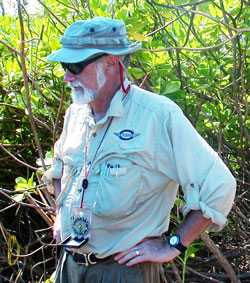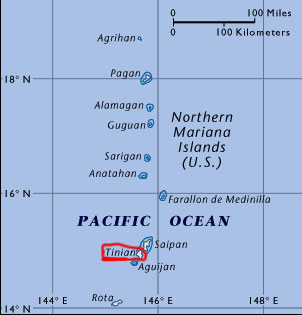 |
Earhart Project Research Bulletin
November 7, 2003
| Earhart on Tinian? |

An
Informational Report by Thomas F. King, Ph.D., Project Archaeologist,
TIGHAR Amelia Earhart Search Project
Tinian is an island in the Northern Marianas, not far from Saipan, the capital of what is now the Commonwealth of the Northern Mariana Islands (CNMI). During World War II it, like the rest of the Marianas, was held by the Japanese. After its capture by U.S. forces it was heavily developed as a base for heavy bomber operations, and is famous as the site from which the nuclear raids on Hiroshima and Nagasaki were launched. Much of the island is a U.S. National Historic Landmark as a result of its role in World War II. It is also a municipality of the CNMI, whose “Commonwealth” relationship with the United States is roughly comparable with that of Puerto Rico.
 Mr.
Saint John Naftel, an 81-year-old World War II veteran from Alabama who
was stationed on Tinian in 1944, says that while there he was approached
by a man of Hawaiian background, an erstwhile hired laborer for the Japanese,
who said he had taken part in burying a white woman and man in “aviator’s
suits” on the island in 1937. Mr. Naftel says he was shown the site
where the bodies were buried, and that he believed them to have been the
remains of Amelia Earhart and Fred Noonan.
Mr.
Saint John Naftel, an 81-year-old World War II veteran from Alabama who
was stationed on Tinian in 1944, says that while there he was approached
by a man of Hawaiian background, an erstwhile hired laborer for the Japanese,
who said he had taken part in burying a white woman and man in “aviator’s
suits” on the island in 1937. Mr. Naftel says he was shown the site
where the bodies were buried, and that he believed them to have been the
remains of Amelia Earhart and Fred Noonan.
Mr. Naftel’s story apparently interested a friend of his, Florida attorney Elliott P. Broughton, enough that Mr. Broughton contacted the U.S. Navy on Guam. His letter was routed to Jennings Bunn, the Navy’s archeologist on the island. Bunn spoke with Naftel and was sufficiently impressed that he made arrangements to cover the cost of Mr. Naftel’s travel to Tinian to point out the site where he had been told the graves were to be found.
In the course of making his arrangements, Mr. Bunn contacted TIGHAR for advice. We advised him that Mr. Naftel’s story sounded like another of the many, many anecdotal accounts we have all heard, and that have often been published, of Earhart’s demise at the hands of the Japanese. However, since Mr. Naftel’s recollections could be tested – he was willing to point out the site where the bodies ought to be found, and it would be possible to conduct archeological research to see if they were really buried there – we encouraged him to proceed, and two archeologically trained TIGHAR members – Gary Quigg and I – have offered to help excavate if he gains permission to do so and we can find our ways to the island. Every hypothesis, we think, deserves testing.
In October of this year, Mr. Naftel visited Tinian in Mr. Bunn’s company, and pointed out the spot where he said he had been told the bodies had been buried. I understand that Mr. Bunn is now developing a proposal to excavate the site, but at last report, the CNMI Historic Preservation Officer advised that he had not yet received a proposal. The CNMI has one of the strongest historic and archeological preservation laws in the world, and excavation without a permit would be illegal.
Mr. Naftel’s story, and Mr. Bunn’s efforts to help him identify the site he was shown, have gotten a good deal of press, and have – as usual – generated expectations that a solution to the Earhart mystery is right around the corner. However, even if TIGHAR didn’t have what we believe is far stronger evidence supporting (but not proving) the hypothesis that Earhart and Noonan landed and died on Nikumaroro in the Phoenix Islands, not on Tinian, there are things about Mr. Naftel’s story that would make us skeptical of its veracity.
In the first place, it is an anecdotal account of an anecdotal account – Mr. Naftel’s recollection of what someone else told him he recollected. There is a tremendous amount of room for honest error in the transmission, retention, and recollection of such accounts.
Second, of course, it contradicts not only TIGHAR’s Nikumaroro Hypothesis but every other hypothesis that’s been advanced about Earhart’s fate. This doesn’t mean that it’s wrong; it just means that for it to be right all the other hypotheses have to be wrong – even the several others that have Earhart and Noonan being captured and executed by the Japanese on Saipan, in Chuuk (formerly Truk) and elsewhere in Micronesia.
Third, the main descriptive statement on whose basis it is assumed that the bodies were those of Earhart and Noonan – that they were wearing “aviator’s suits,” actually argues against the bodies being theirs. Dozens of photos taken during the World Flight show that Earhart wore a sport shirt, slacks, and sometimes a leather jacket while flying. Noonan wore slacks, a dark shirt and a tie. Motion picture film (viewable on this website) of them boarding the Electra for the final flight confirms that they wore no “aviator’s suits.”
Finally, there were almost certainly other “white women and men” in the Northern Marianas in the 1930s, and some of them may well have been rounded up by the Japanese and perhaps, for some reason, executed. There were German, Spanish, British, and American missionaries operating in the area, as well as at least a few intelligence agents, and the substantial American base at Guam was not far off. There is no way of knowing how many recreational or otherwise undocumented sailors may have found their way into the Japanese-administered islands of Micronesia. When I was last on Guam I had an interesting conversation with Mr. Tony Palomo, one of Guam’s eminent historians who in the 1960s was a reporter for the Guam Daily News. Having gotten interested in the Earhart story because of Fred Goerner’s 1966 book, The Search for Amelia Earhart, Mr. Palomo interviewed a number of authorities on Saipan and found no evidence to support the idea that Earhart had wound up in the Marianas. At the same time, however, he noted that there were quite a number of White Russian families who had found their way into the area in the wake of the Russian Revolution; he told me, in fact, that there’s a woman living in Yap today – an island group south of the Marianas – who is of White Russian descent and closely resembles Earhart. This is not implausible, given Earhart’s northern European ethnic background. In short, there may have been no dearth of “white men and women” other than Earhart and Noonan with whom the graves on Tinian could have been filled.
It is to be hoped, though, Mr. Bunn will obtain permission to excavate, and Mr. Naftel’s story can be tested. The mere discovery of bones won’t prove the case, however; the Northern Marianas are littered with human bones, as a result of their dense occupation over the last five thousand years or more, plus the widespread killing and suicide that accompanied the 1944 invasion. Any bones found will either have to be associated with very definitive artifacts or be found to contain DNA matching Earhart’s or Noonan’s. Earhart has surviving relatives who might contribute comparative samples; no living Noonan relatives have yet been located.
In my judgment, there is no reason to view the Tinian story as anything more than one more thus-far unsubstantiated anecdotal account, though one that does have the potential for being proved true or false through independent research. I hope that Jennings Bunn gets to excavate, but I think the likelihood that he’ll confirm what I suppose we can call the “Tinian Hypothesis” is slim. Given all the evidence we’ve collected, the chances of confirming TIGHAR’s Nikumaroro Hypothesis appear far higher, provided we can raise the money to undertake another round of serious archaeological work on the island, in the colonial village and at the Seven Site. Click HERE to read about our current work. Click HERE to read about the excavation on Tinian.
